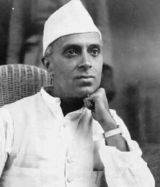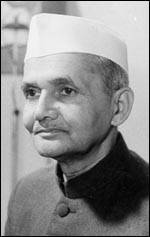Indo-Lanka Relationships
My Memories
by R. Cholan
|
Current Indian analysts mesmerized by the famed Sinhala hospitality may not fully comprehend all of this. The new chumminess is interpreted as Sri Lanka’s final acceptance of India’s regional super-power status. Given past history, and the subliminal Indophobia that still exists, this is an obviously flawed assumption.... President Jayewardene once said at a news conference in Hong Kong, “the Sri Lankan government will accept help from the devil himself” to fight the Tamils. Currently, the Sinhala leaders are consorting with the Indian 'devil' for this help.
|
One of my earliest memories of the Colombo harbor was of a large graffiti on a wall (facing the sea and the ships), which read: “INDIA GO HOME”.
I grew up in Colombo in the forties and fifties, witnessing the many manifestations of Indophobia in Sri Lanka. It was called Ceylon then. The Indophobia of that era was not limited to graffities – it was everywhere. The Sinhala disdain for anything Indian was open and omnipresent. All Indians were called Kalla-Thonis, a derogatory term coined originally to describe smugglers and illegal immigrants. Even in the educated middle-class households this term was freely used to describe Indians.
Indian traders, who were in the country in significant numbers at that time and patronized regularly by the Ceylon Tamils, were shunned by the Sinhalese. Indian grocery-stores had hardly any Sinhala customers. Indian textile merchants sold their saris only to Ceylon Tamil customers and the Sinhalese bought theirs from Sinhala owned shops. Indian restaurants were frequented mostly by Tamils, except for a few Sinhalese who bought ‘one’ Dosa (for 10-cents) in the sixties, for the ‘unlimited’ sambar and sambal that came free with it! At the Sinhala owned Restaurants, a bread-meal (1/4 lb of bread for 25-cents) got them only two small dishes of parippu and sambol – No seconds!
Analysts who today sing the praises of a healthy Indo-Lanka trade relationship probably have no idea of what I am talking about. They were not there then to know. Perhaps a simple chat with a Tamil clerk, who lived in the Sinhala towns at that time, would be illuminative to these pundits. Any Indian who cares about the future Indo-Lanka relationship must research the events of that era.
Quite apart from the ordinary Sinhala citizen’s scorn towards the Indian traders, there also existed a state level Indophobia. From the fifties on, a series of measures were taken by successive Sri Lanka governments to make life harder for the traders from the south Indian states of Madras and Kerala. The end result – by the mid-sixties these Indian traders had completely disappeared from Sri Lanka.
The first of these administrative acts was the requirement that all non-Ceylonese businessmen register themselves, for a fee of Rs. 400.00, a huge burden to these small time traders from India at that time. Indian grocers, who eked out meager profits by selling Indian eggs for 18-cents, as opposed to the local price of 21-cents, couldn’t afford this fee. Most chose to leave the country.
Imports of groceries and magazines from India were then banned – not just deterred with increased tariffs, but a complete ban. Readers of Indian magazines, like Femina (English) and Kalki (Tamil), couldn’t get them anymore. What the hell, these readers were only a miniscule minority and besides most were Tamils. Those who could afford it got them in the black-market anyway, and the rest of the readers didn’t matter.

Jawaharlal Nehru |
Ironically, Tamil farmers in the north Sri Lanka welcomed the ban on Indian onions, as the price of Jaffna onions skyrocketed (as did their profits), little realizing what the Sinhala government was doing. When the Sinhala farmers started growing onions, the transport of onions from Jaffna was bottlenecked at the Elephant Pass army checkpoint, with a ‘permit’ requirement. Those in Jaffna (me included) ate onions for breakfast, lunch and dinner! Indian onions were nowhere to be seen.
The Indophobia of that era also resulted in the Sinhala government going after the so called Tamils of ‘recent’ Indian origin. These immigrant plantation workers imported by the British more than a hundred years earlier had already been stripped of their Ceylon citizenship by a prior legislation – the first Legislative Act of the newly independent Ceylon in 1948. Since then, these Tamils had been living in Ceylon as ‘stateless’ persons.
India came under increasing pressure from the Sinhala leadership to accept a forced repatriation of these stateless Tamils. The first Indian PM, Jawaharlal Nehru, who had resisted the pressure effectively, died in 1964. A weak leadership that followed, and the fact that India was distracted at that time by a war with China, gave the Sinhala leadership the best opportunity to ratchet-up the pressure. The new Prime Minister Lal Bahadur Shastri caved-in, agreeing to accept more than 50% of the stateless Tamils (Sirimavo-Shastri Pact; October 1964). Over 500,000 Tamil plantation workers were forcibly deported.

Lal Bahadur Shastri |
Intoxicated with this success, Sri Lanka was relentless against its large neighbor, and succeeded on many fronts. The island of Kachchativu, a piece of Indian Territory, was wrenched from India in 1974 with similar pressure tactics. It must be remembered that the wrangle for this piece of Indian land occurred less than three years after the first JVP insurrection (1970), when India was the first to come to the rescue of the Colombo government. That’s Gratitude.
The next major issue with India was when India came to help in the ethnic conflict in 1987, and ended up eating humble pie. Lured by one president to help fight the Tamil rebels, India was booted out by the next, who mockingly joined hands with the same rebels to kick India out. It was a classic example of Sinhala leaders’ penchant to renege on solemnly signed agreements.
If India's meek and complete acquiescence to its little neighbor is to keep out its northern detractors from the island, it is obviously a failed strategy. India never enjoyed a reciprocal loyalty from the Sri Lankans. Contrarily, the Chinese and the Pakistani presence and influence in Sri Lanka have been significant and at present growing alarmingly.
It is hoped, at the highest echelons in India, that helping Sri Lanka fight the Tamils will somehow diminish the Chinese and Pakistani influence there, at least in the short-term. Quite apart from the fact that this policy has not produced the desired results even in the short-run, the long-term outlook for India if Sri Lanka wins the war against the Tamils is even gloomier.
A strong Tamil presence in the Sri Lankan polity (either federal or as separate countries) is India's best bet. It is the only way India can counterbalance the congenital and hereditary Sinhala Indophobia.
I base this on another of my early childhood memories in Sri Lanka. It is about my own home and that of my relatives and friends. Every Tamil home during that period had a framed photo of Mahatma Gandhi displayed in their living rooms. Many had pictures of other Indian leaders, like Jawaharlal Nehru, Subash Chandra Bose, etc. as well. In some cases these were kept in their shrine rooms among pictures of their gods. No Sinhala home ever had pictures of Indian leaders.
Sri Lankan Tamils are the natural allies of India. The Sinhalese are congenitally and hereditarily ill-disposed towards India, perhaps their attitude being rooted in the historical memories of invasions in centuries past, or the Mahavamsa teachings, or whatever. Merits of these dissimilar dispositions apart, it is the ground reality. It is something that India needs to understand and recognize, or ignore at its own peril.
Current Indian analysts mesmerized by the famed Sinhala hospitality may not fully comprehend all of this. The new chumminess is interpreted as Sri Lanka’s final acceptance of India’s regional super-power status. Given the past history, and the subliminal Indophobia that still exists, this is an obviously flawed assumption. The Sinhala leaders are acting friendly today only for India’s help to crush the Tamil rebellion. President Jayewardene once said at a news conference in Hong Kong, “the Sri Lankan government will accept help from the devil himself” to fight the Tamils. Currently the Sinhala leaders are consorting with the Indian devil for this help.
A politically weakened Tamil population in Sri Lanka will in the long run result in the realization of India's worst nightmare. Nothing can be worse for India than a country in its backyard, ruled by an innately hostile population. India needs a strong Tamil hand in Sri Lanka, and the sooner it understands this basic fact the better it is for them.
A Chastened Indian Foreign Secretary, Jyotindra Dixit, six years after his debacle in Sri Lanka, told me something privately, which he didn’t (or couldn’t) say openly in his book, Assignment Colombo (1998). He said to me “I say, if I were Prabakaran, I won’t trust any of the Sinhalas. Tell him that I told you so.”
I never have had the opportunity to tell Mr. Pirpaharan that.
|  Home
Home Archives
Archives Home
Home Archives
Archives